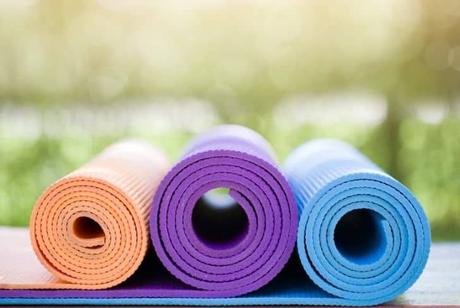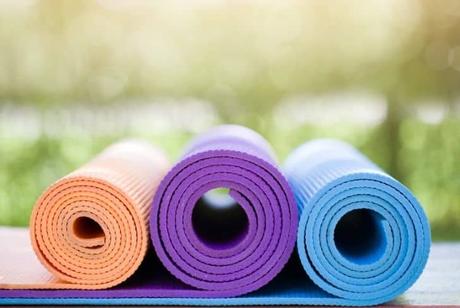Are Yoga Mats Recyclable?
It feels very incredible, just working out from the comfort of your home, at one’s pace. For such, you tend to use a yoga mat, which, in time, can become outdated, requiring a new one, and disposing of the old one. However, is it possible to do something else with that old yoga mat, rather than throwing it away in the trash? This article provides more details

Can You Recycle Yoga Mats?
Yes, some yoga mats are recyclable. According to Earth911, in 2008, more than 50% of mats collected were upcycled into other products, and more than 30% of mats collected were donated to local community programs. In general, the recyclability of a yoga mat depends on the material from which it is made.
Most yoga mats are made of materials such as natural rubber, latex, polyvinyl chloride (PVC) or plastic, making them difficult to recycle and dangerous to either incinerate or throw away into water streams.
Although PVC materials, including yoga mats, contain dangerous chemicals and are difficult to recycle, some businesses specialize in recycling certain types of PVC products, like gift cards and vinyl siding. However, most products made from PVC, most notably consumer products like records, toys and yoga mats, are difficult or impossible to recycle.
Regardless, there are some great alternatives to PVC yoga mats, which are recyclable. Recycle Nation has outlined several companies which make recyclable yoga mats. Companies such as Manduka and JadeYoga, make mats from all-natural rubber, making them completely recyclable.
Other companies such as Barefoot Yoga, make yoga mats from a combination of polyester and Polyolefin, which they claim is completely biodegradable, although the polyester will not break down over time. Also, Yogasana makes another alternative to PVC mats as theirs are made from cotton, which is hand-woven in India.
Recycle Nation adds that at JadeYoga, they have a program that sees to reusing and recycling yoga mats. Those in good shape are given to community centers and retirement homes. Those that cannot be reused are recycled into new mats by the same company.
Sanuk, a California-based footwear company turns unwanted yoga mats into a line of flip-flops for women. They have about 15 different styles of Yoga Mat sandals, that include flats and wedges and although the footwear comes in black soles, the fabric over the top of the foot is available in different colors and patterns.
Are Yoga Mats Biodegradable?
Yes, and no! Like recycling yoga mats, the biodegradability of yoga mats depends on the material from which the mat is made.
The majority of yoga mats are made with polyvinyl chloride, also known as PVC, which, although is a good choice because of its non-stick qualities, is a bad choice for the environment. This is in part due to the toxic chemicals that also make up the mat, including phthalates, lead and cadmium.
This particular type of plastic, making up yoga mats, is difficult, not only to recycle but also to biodegrade. If sent to the trash, which in most cases means the mats end up in landfills, they will not biodegrade. Additionally, they will release the toxic chemicals onto the land, and surrounding bodies of water.
On the other hand, some companies have noticed this, and are making biodegradable and recyclable yoga mats. A company like Yoga Design Lab makes yoga mats out of biodegradable natural tree rubber. They also use bales of plastic bottle waste made from polyethylene terephthalate (PET) that have been supplied by recycling collectors and then eventually transformed into mats.
Also, as mentioned above, JadeYoga and Manduka make mats from all-natural rubber, Yogasana make their from cotton, and Barefoot Yoga make theirs from a combination of polyester and Polyolefin, which they claim is completely biodegradable. All these are alternative mats that are biodegradable and safer for the environment as compared to PVC yoga mats.
Are Yoga Mats Eco Friendly?
Again, the answer here is both yes, and no. like the two major points discussed above, the eco-friendliness of yoga mats is dependent on the material making the yoga mat.
The biodegradable variety can be classified as eco-friendly, seeing that it can decompose in the ground after a while. This means such yoga mats will disintegrate without causing harm to the environment.
The problem arises when it comes to PVC yoga mats, which make up a sizable percentage of all yoga mats in the world. They are hands down, the worst for the environment. For starters, PVC requires a lot of water and petrochemicals to manufacture.
The National Institute of Health associates areas around factories that use vinyl chloride with increased cancer risks. PVC contains phthalates, linked to both health and environmental impacts, in addition to other toxic additives. Secondly, disposing of PVC mats is not easy and is accompanied by various health and environmental hazards.
PVC is non-biodegradable, making it impossible to recycle and thousands of years from now your yoga mat will still be sitting exactly where it ended up in your local landfill. The remaining avenues of discarding the yoga mat are not safe. If it ends up in landfills, the toxic chemicals making it will leech into the land over time.
These chemicals will end up finding their way into underground waters, or rivers, contaminating the drinking water for a very long time. Let us also not forget that when you are using the yoga mat, you are breathing in some of the chemicals from the yoga mat. Also, if you decide to set it on fire, the phthalates, lead, cadmium and a compound called dioxin can all be released into the air, harming anyone who breathes it.
Are Rubber Mats Toxic?
No, rubber yoga mats are not toxic. Natural rubber yoga mats are sourced from rubber trees, which produce a milky-white sap. It is tapped, harvested and then processed without requiring the tree to be cut down. This makes the entire process sustainable and more to this, the subsequent yoga mats are made without any plasticizers or additives, making them biodegradable.
Rubber offers grip, durability, cushioning, and both open-cell and closed-cell options, making for a great all-natural yoga mat. They can however have a smell that puts off some people. They also fade with time, although they can be cleaned with a 1:1 water-vinegar solution which speeds us the cleaning process. Regardless, rubber yoga mats are recyclable and fully biodegradable, meaning they are safe for the environment and their users.
Thermoplastic elastomer (TPE) yoga mats are a synthetic material, made also from rubber, although, mixed with plastic. The TPE variety makes closed-cell yoga mats that are both more hygienic and easy to clean. They have been branded as a safe choice since being introduced in the quest for a more environmentally-friendly alternative to PVC yoga mats.
They do not contain phthalates, making them a better choice than PVC, although they still contain some plastic. TPE mats are technically recyclable, although it takes time to get a facility that will recycle them. They are also technically biodegradable, only hindered by their plastic side, which takes time before completely breaking down.
8 Impressive Ways To Reuse Old Yoga Mats
1. Camping
Old yoga mats can come in really handy when you are going camping, hiking or fishing. Of course, it is not to use them for yoga, but as mats, for the mud, you might carry along with you before entering the sleeping bag or tent.
Be sure to bring those old yoga mats with you on your next expedition, and you will be grateful to them for not bringing in mud into the camping tent. In line with stepping on old yoga mats before going somewhere, they can also be used near a pool, so that you step on them, without getting all grassy or cement fried when you step out.
2. As ‘beds’ for animals
You can use old yoga mats with your animals, either young or older, to sleep on. You can also donate them to animal shelters, and they will make comfortable sleeping places for puppies, cats and adult dogs.
You can also use them as placemats for pet bowls where you will not have to keep on cleaning after every other spilled bowl. Cut your old mat into your desired shape or design and place the pet’s bowl on the mat
3. Knee pads
Some activities require you to kneel, and you will end up hurting your knees if you do not have knee pads. Why not just make some from that old yoga mat. Whether it is for your next gardening session or for doing the household chores, you can repurpose your old yoga mat by turning them into knee pads. You can also wear knee pads when playing with your children, to make them happy, without hurting your knees
4. Give them to a newbie
You can as well give out your old yoga mat to someone who is new to or wants to join yoga. It is a practice that dates back centuries and will continue for centuries to come. Instead of someone new to yoga buying another PVC mat and add to our waste, why don’t you donate yours to them? Giving out a gently used yoga mat for free is an ideal gift for a newbie to yoga.
5. Shelf liners
You can chop that old yoga mat into a size that will fit your kitchen cabinets or shelves. They are perfect for use as shelf liners and will help keep your kitchen tidy.
6. Donate to artists
You can also give out your old yoga mats to artists who make sculptures. They can provide a cushion for the knees while they work or even better, maybe they will create an invention or an art piece with the old yoga mat.
7. Donate to local retirement centers
You can give out your old yoga mat to a local retirement community. Many such institutions run yoga classes and they would be grateful for your donation.
8. General home use
Old yoga mats can also be used at home for other general tasks, apart from the ones already mentioned. You can cut an old yoga mat and make it into a mouse pad, insoles for your shoes, block heat in the car, for child safety in your children’s playroom, and to cover sharp edges on your tables.
You can also use them as planning boards for your projects at home, under flowerpots or vases to avoid leaking water from the pots from leaking to the floor, as stair treads, like coasters or even as doormats. You can also use them to open jars or lids, you can make napkin rings out of them, turn them into a storage box or even fashion out a clutch out of a yoga mat.
References:
https://www.latimes.com/lifestyle/story/2019-07-18/yoga-mats-bad-for-environment
https://www.health.com/fitness/reuse-a-yoga-mat


